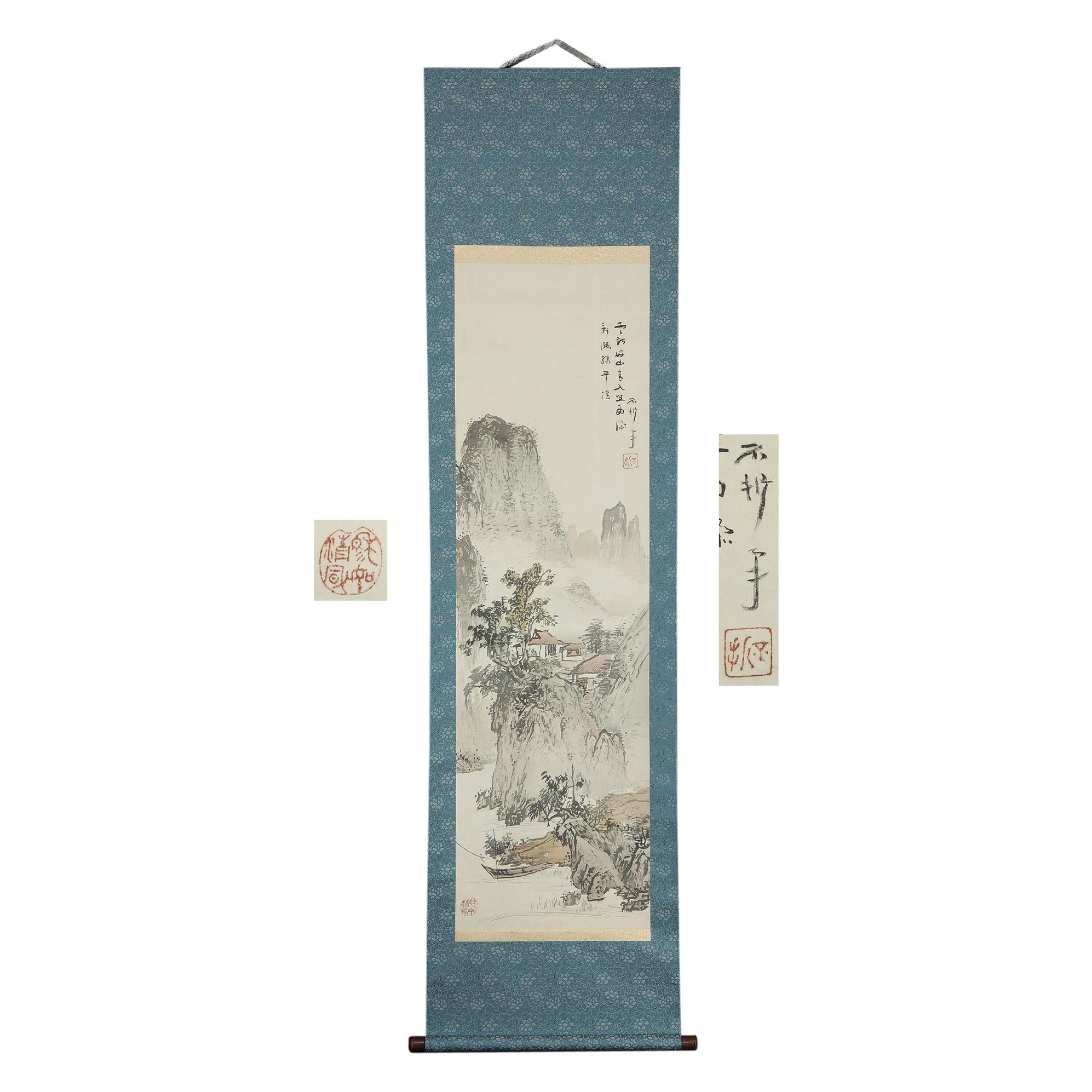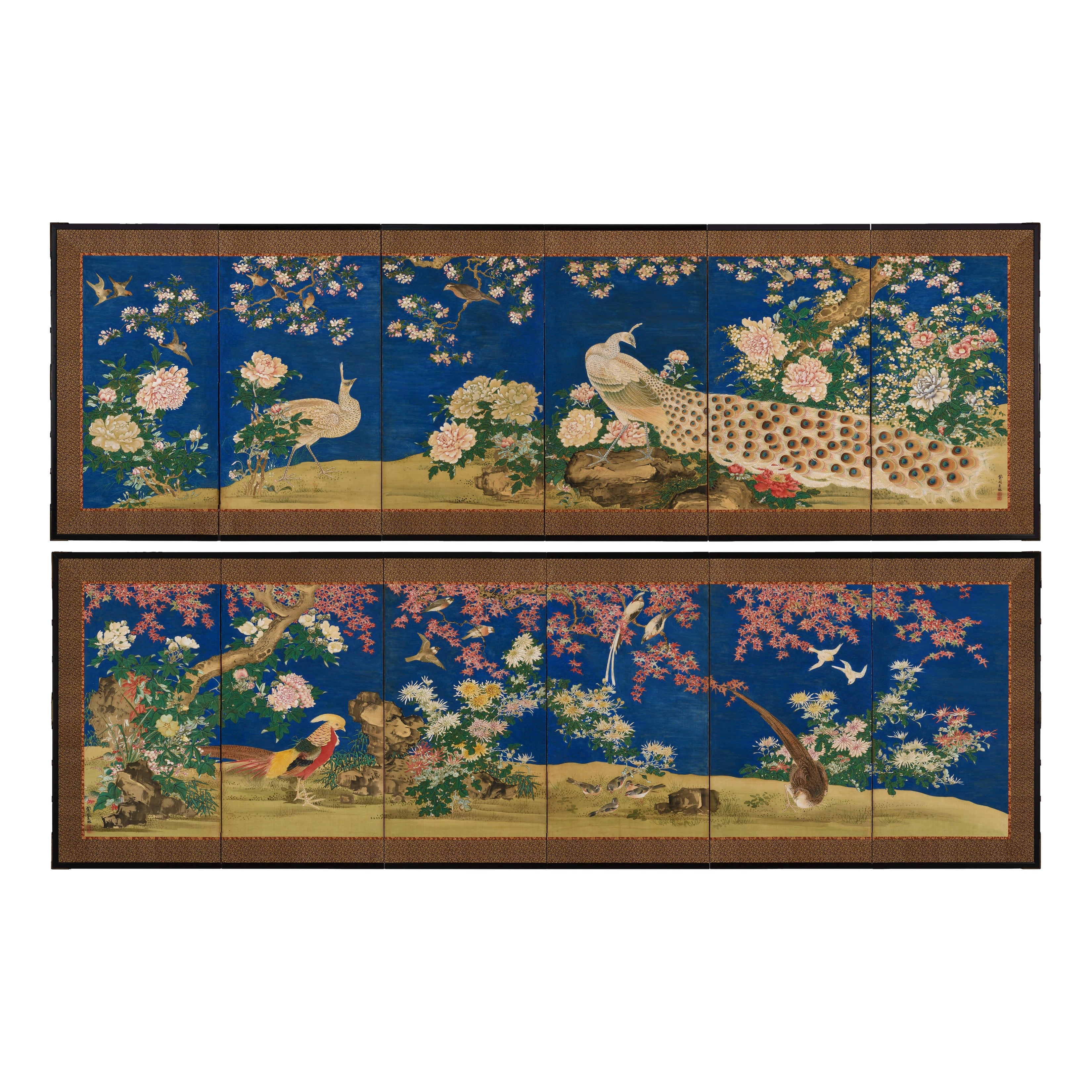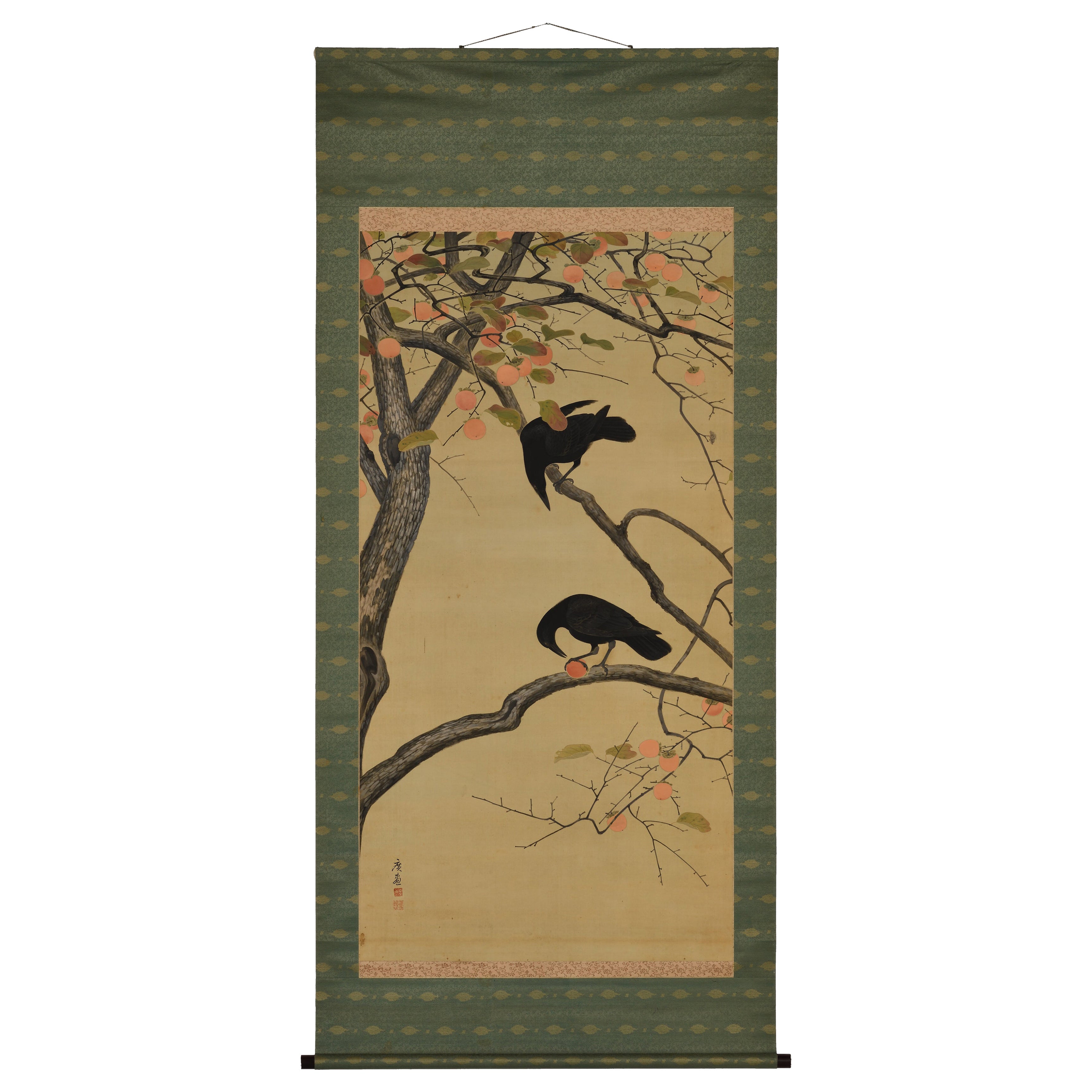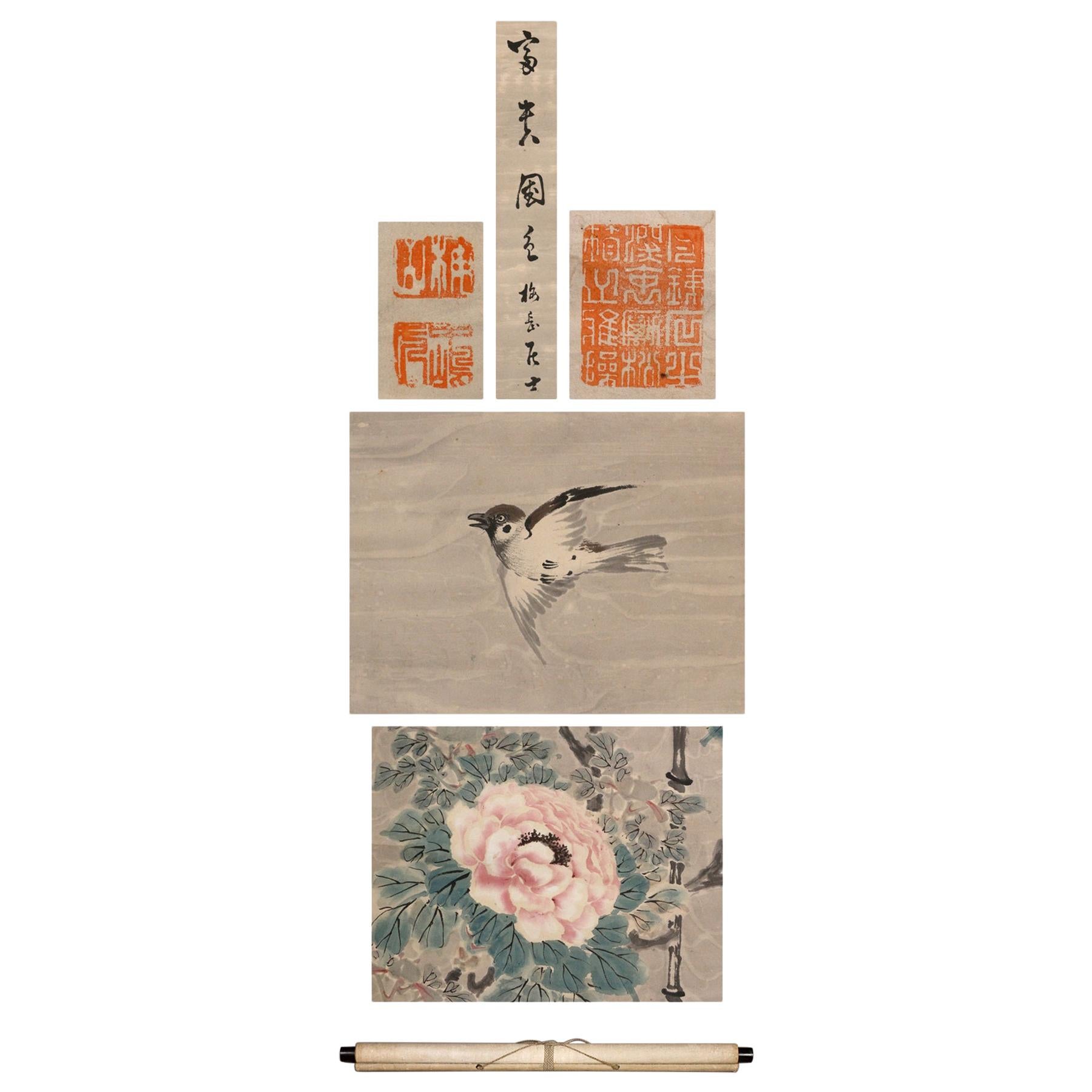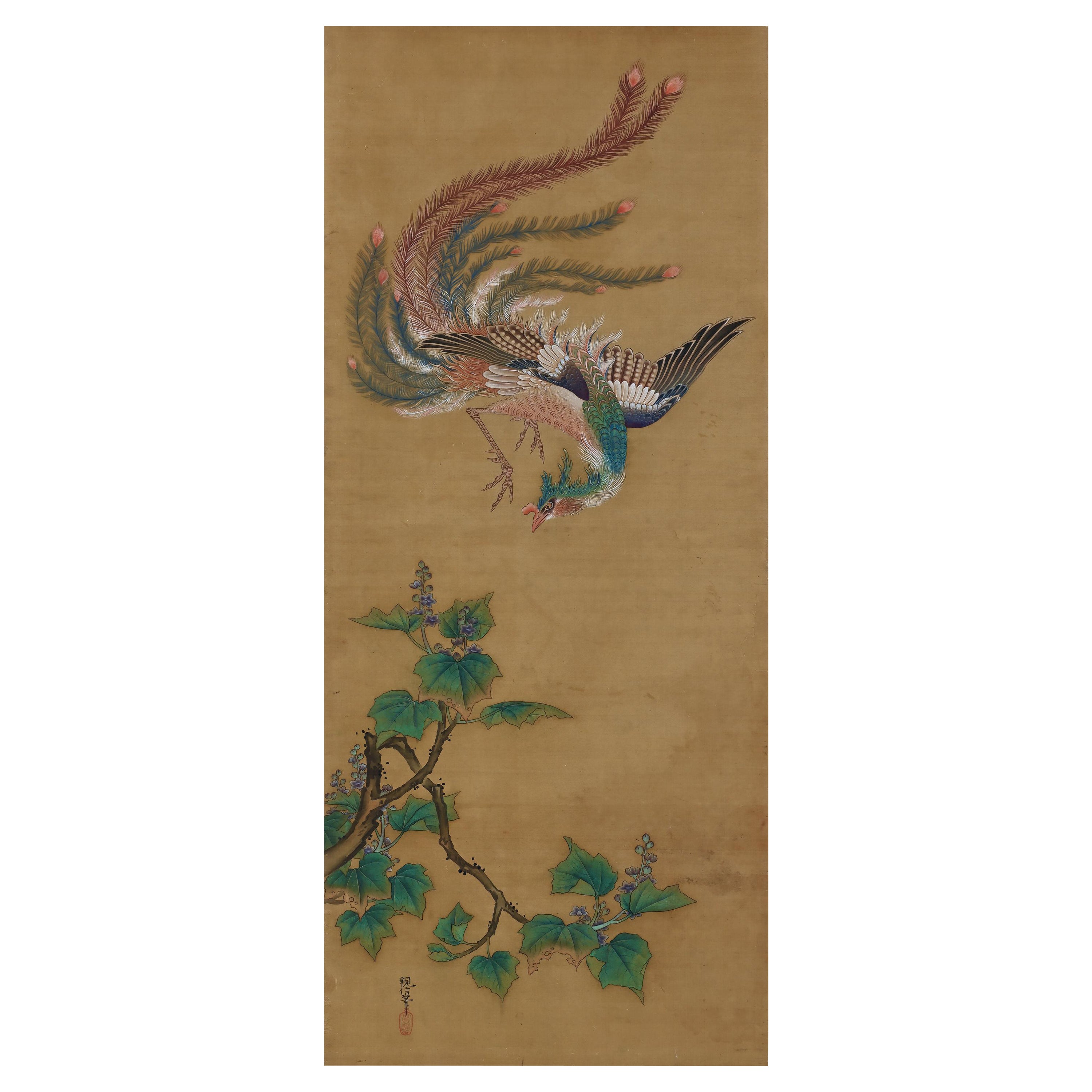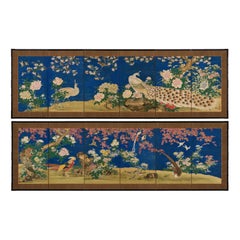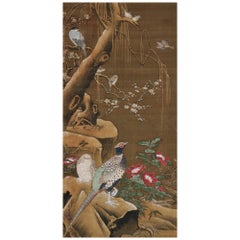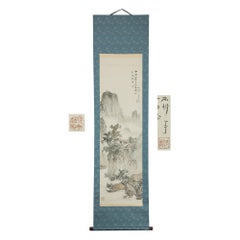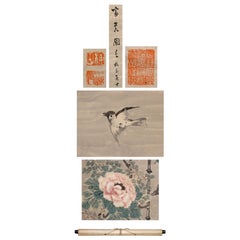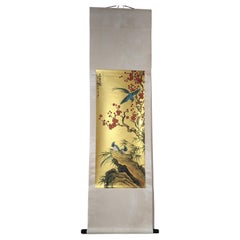Items Similar to 19th Century Japanese Scroll Painting, Birds & Flowers of the Four Seasons
Want more images or videos?
Request additional images or videos from the seller
1 of 9
19th Century Japanese Scroll Painting, Birds & Flowers of the Four Seasons
$10,800
£8,014.02
€9,335.23
CA$15,033.68
A$16,741.36
CHF 8,712.95
MX$206,418.91
NOK 110,966.10
SEK 104,297.37
DKK 69,652.43
Shipping
Retrieving quote...The 1stDibs Promise:
Authenticity Guarantee,
Money-Back Guarantee,
24-Hour Cancellation
About the Item
Birds and flowers of the four seasons
Early to mid-19th century
Ink, pigment and gofun on silk
Unidentified artist
Signature: Shuho
Seal: Shuho ga in
A large Japanese bird and flower scroll painting from the late Edo period. It is a tour-de-force work of naturalistic painting. All four seasons are represented though they are mixed together without a pattern specifically based on the times of the year. There is instead a rhythmic balance between sizes, colors and shapes. In combination with the dynamic composition, the exquisite representation and refined color expression result in a picture plane filled with vitality. The painting, paired with the patterned silk brocade creates a sumptuous visual effect.
The large format, complex composition and profusion of details are all derived from Chinese Ming dynasty bird-and-flower paintings. In the same manner, most of the birds are exotic. The work is focused on two silver pheasants surrounded by orioles, finches, waterfowl, a crested myna and a kingfisher that enliven a natural landscape. Winter camellias and spring plum blossoms profligate in the upper fields while the lower fields depict summery waterways highlighted with Japanese spatterdock. Flowering white chrysanthemums of autumn flourish through the middle ground.
- Dimensions:Height: 86.5 in (219.71 cm)Width: 40 in (101.6 cm)Depth: 1 in (2.54 cm)
- Style:Edo (Of the Period)
- Materials and Techniques:
- Place of Origin:
- Period:
- Date of Manufacture:circa 1830
- Condition:Refinished. Wear consistent with age and use. The painting has recently been restored and remounted in Kyoto utilizing traditional materials and techniques.
- Seller Location:Kyoto, JP
- Reference Number:1stDibs: LU2472328148072
About the Seller
5.0
Recognized Seller
These prestigious sellers are industry leaders and represent the highest echelon for item quality and design.
Established in 2001
1stDibs seller since 2016
70 sales on 1stDibs
Typical response time: 6 hours
- ShippingRetrieving quote...Shipping from: Kyoto, Japan
- Return Policy
Authenticity Guarantee
In the unlikely event there’s an issue with an item’s authenticity, contact us within 1 year for a full refund. DetailsMoney-Back Guarantee
If your item is not as described, is damaged in transit, or does not arrive, contact us within 7 days for a full refund. Details24-Hour Cancellation
You have a 24-hour grace period in which to reconsider your purchase, with no questions asked.Vetted Professional Sellers
Our world-class sellers must adhere to strict standards for service and quality, maintaining the integrity of our listings.Price-Match Guarantee
If you find that a seller listed the same item for a lower price elsewhere, we’ll match it.Trusted Global Delivery
Our best-in-class carrier network provides specialized shipping options worldwide, including custom delivery.More From This Seller
View AllMid 19th Century Japanese Screen Pair. Flowers & Birds of the Four Seasons.
Located in Kyoto, JP
Shioka Sorin (1781-1850)
Flowers & Birds of the Four Seasons
Pair of six-panel Japanese Screens. Ink, gofun and pigments on silk.
Dimensions (each screen): H. 91.5cm x W. 285cm (3...
Category
Antique Mid-19th Century Japanese Edo Paintings and Screens
Materials
Silk
Early 20th Century Japanese Nihonga Scroll. Crow & Persimmon.
Located in Kyoto, JP
Anonymous.
Crows & Persimmon
Japanese Scroll. Pigments and Ink on Silk.
Dimensions:
Scroll: H. 235 cm x W. 106 cm.
Image: H. 168 cm x W. 86 cm.
Bird and flower paintings are oft...
Category
Early 20th Century Japanese Taisho Paintings and Screens
Materials
Silk
19th Century Japanese Silk Painting by Kano Chikanobu, Phoenix & Paulownia
Located in Kyoto, JP
Birds & Flowers of the seasons
Pheasants & Plum in Snow
Unframed painting. Ink, pigment and gofun on silk
Kano Chikanobu 1819-1888
Signature...
Category
Antique Mid-19th Century Asian Edo Paintings and Screens
Materials
Silk
Japanese Painting. Bird and Flower. 19th century copy of Lu Ji by Ogata Tomin.
Located in Kyoto, JP
Ogata Tomin (1839 -1895)
Birds in a spring landscape
Ink and colour on silk.
Inscription reads:
“Copy of Lu Ji, painted with heartfelt appreciation”
“Painted by Tomin Ogat...
Category
Antique Late 19th Century Japanese Ming Paintings and Screens
Materials
Silk
19th Century Japanese Screen Pair. Flowers & Birds of the Four Seasons
Located in Kyoto, JP
Flowers & Birds of the Four Seasons
Pair of six-fold Japanese Screens. Ink, color, gofun and gold on paper.
Second half of the 19th Centur...
Category
Antique Late 19th Century Japanese Meiji Paintings and Screens
Materials
Wood, Paper
Meiji Era, Circa 1900 Japanese Screen Pair, Flowers & Birds of Spring & Autumn
Located in Kyoto, JP
Flowers & Birds of Spring and Autumn
Unknown artist.
Japan. Meiji period, circa 1900.
A pair of six-fold screens. Ink, color, gofun and gold leaf on paper.
Signed: Gaga S...
Category
Antique 1890s Japanese Meiji Paintings and Screens
Materials
Gold Leaf
You May Also Like
Japanese Silk Scroll Painting of Moneys Edo Period Mori Tetsuzan
Located in Atlanta, GA
A Japanese mounted vertical hanging scroll painting by Mori Tetsuzan (Japanese, 1775-1841) circa 19th century Edo period. The watercolor and ink on silk ...
Category
Antique 19th Century Japanese Japonisme Paintings and Screens
Materials
Silk, Paper
Lovely Fusetsu NakamuraScroll Painting Japan Artist Flowers Painted
Located in Amsterdam, Noord Holland
Fusetsu Nakamura
1866-1943
of the Showa-life painter and calligrapher
Tokyo students
real name: Taro
issue: Fusetsu, Kanzan, Anakatatei, Goinoshishi teacher, long life, Reitsubotoki
...
Category
Mid-20th Century Japanese Showa Paintings and Screens
Materials
Silk
$1,588 Sale Price
20% Off
Lovely Nihonga Scene Meiji/Edo Period Scroll Japan Artist Flowers and Snow
Located in Amsterdam, Noord Holland
As you can see, this is a work in which a snow fence and a cold peony sparrow figure was drawn by Mt.
In addition to the cold snow peony in the snowfall that makes you feel a myster...
Category
Antique 19th Century Japanese Showa Paintings and Screens
Materials
Silk
$818 Sale Price
20% Off
Old Chinese Zhang Daqian Hand Painting Birds Flowers Paper Wall Decoration
Located in 景德镇市, CN
This exquisite old Chinese hand-painted scroll by the renowned artist Zhang Daqian features delicate birds and vibrant flowers, showcasing his signature brushwork and mastery of trad...
Category
20th Century Paintings and Screens
Materials
Paper
Japanese Meiji Period Painting Scroll Crane Landscape Nihonga Japan Artist Sign
Located in Amsterdam, Noord Holland
Japanse school Kraanvogels en schildpadden in stromend water met Horaisan op de achtergrond
Rolschildering / scroll op papier, houten rollers. B 100.5 x 26.7 / 183.5 x 37.7 cm
100....
Category
Antique Mid-19th Century Japanese Meiji Paintings and Screens
Materials
Silk
$1,492 Sale Price
20% Off
Artists Kashiro Ashimi Meiji Period Bird Scroll Japan 20c Artist Nihonga
Located in Amsterdam, Noord Holland
As you can see, Kashiro Asami brush flower and bird (sparrow) figure Axle.
In addition to the flowers expressed in simple yet calm shades, the
bird (sparrow) seen at the top is a w...
Category
20th Century Japanese Showa Paintings and Screens
Materials
Silk
$751 Sale Price
20% Off
More Ways To Browse
19th Century Flower Paintings
Flower Paintings
Bird Silk Art
Asian Silk Art Birds
Antique Silk Picture
The Four Seasons 19th Century
Finch Birds
Japanese Scrolls
Four Seasons Silver
Hand Painted Pheasant
Antique Hand Planer
Antique Chinese Brocade
Ming Dynasty Silk
Japanese Autumn Screen
Japanese Birds Painted On Silk
Kingfisher Bird
Japanese Pheasant
Japanese Screen Chrysanthemums

